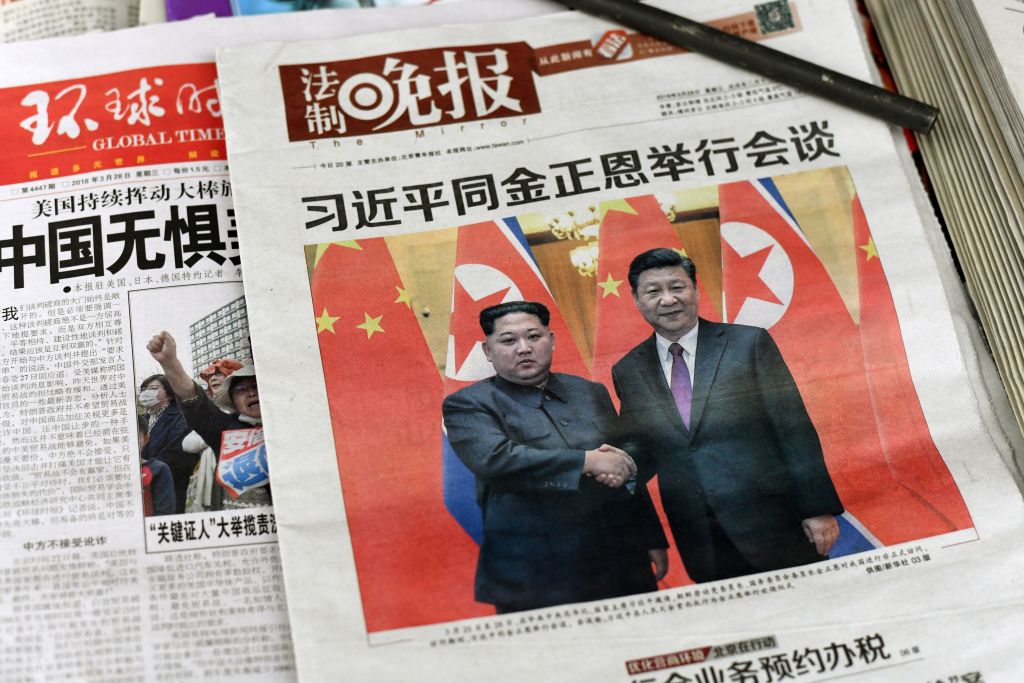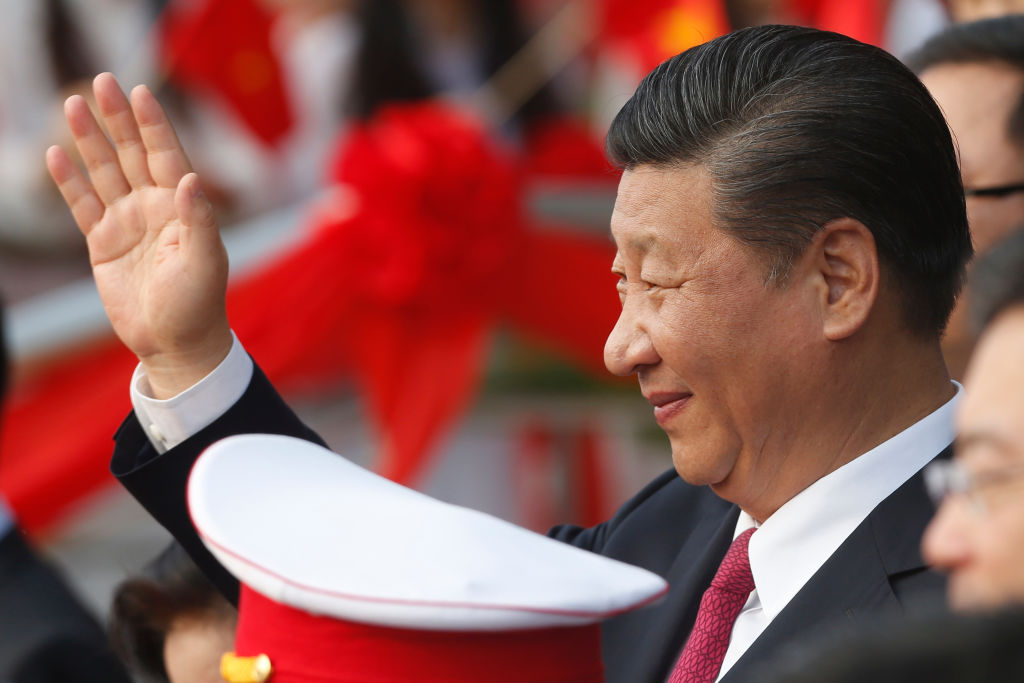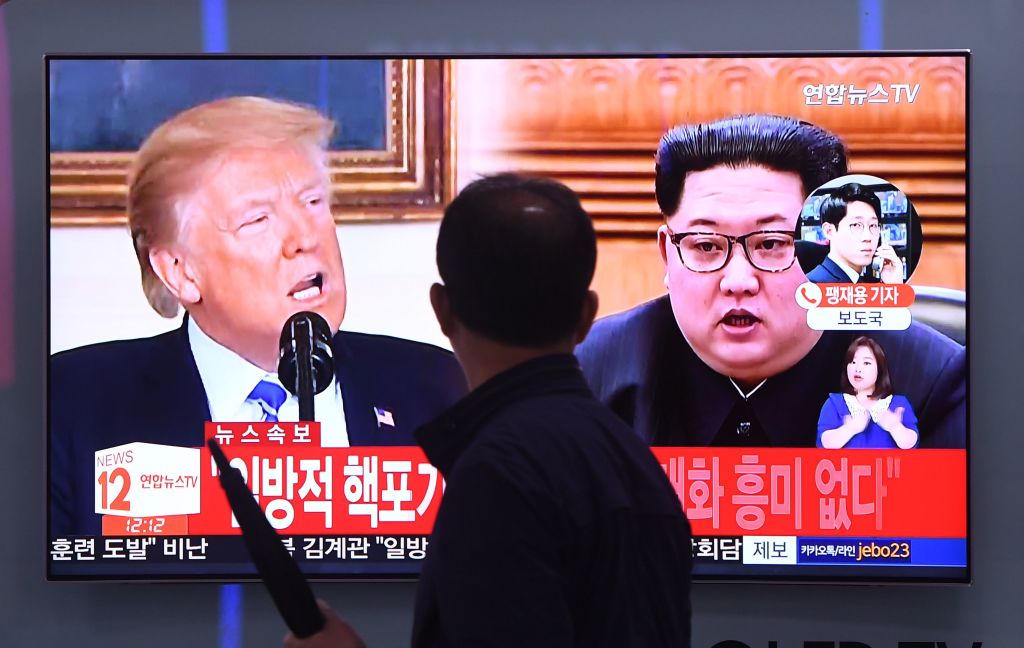During the U.S. Presidential election campaign in 2016, Donald Trump said he was ready to meet North Korean President Kim Jong-un under the "right circumstances" and eat hamburgers with him at the conference table. The right circumstances have arrived, and the two leaders will soon be meeting in Singapore on June 12.
Following the dramatic and intensely emotional meeting between Kim and South Korean President Moon Jae-In, Trump considered meeting Kim also at Panmunjom.
Trump tweeted that there could be an immediate celebration if the talks were successful.
But that would probably raise expectations too high. A meeting at Panmunjom would also place North Korea and China at a disadvantage because China would be left out. Moon, as host, would be involved one way or another.
 The front pages of Chinese evening newspapers, showing images of China's President Xi Jinping with North Korean leader Kim Jong Un, are displayed at a newspaper stand in Beijing on March 28, 2018. Photo by FRED DUFOUR/AFP/Getty Images
The front pages of Chinese evening newspapers, showing images of China's President Xi Jinping with North Korean leader Kim Jong Un, are displayed at a newspaper stand in Beijing on March 28, 2018. Photo by FRED DUFOUR/AFP/Getty Images
China’s backing is essential for North Korea. At North Korea’s request, President Xi Jinping, as General Secretary of the Chinese Communist Party, invited Kim, as Chairman of the Korean Workers Party, to Beijing in late March. It was Kim’s first overseas visit after becoming leader. In early May, Kim visited Xi again for an informal meeting in Dalian.
Despite frosty relations in recent years because of North Korea’s nuclear and ballistic missile tests, China has been North Korea’s staunchest supporter. Over a million Chinese "volunteers" fought in the Korean War. Mao Zedong’s own son died in that war and is still interred in a military cemetery outside Pyongyang. China, together with North Korea, signed the Armistice Agreement with UN Forces led by the U.S. in 1953.
Why they'll be meeting here
Singapore is a friendly, neutral venue for the U.S. and North Korea. It also has excellent relations with South Korea and China. Indeed, also with Japan and Russia, which are the other two countries involved in the Six-Party Talks on North Korea’s nuclear program.
In 2008, when Singapore was in the chair of ASEAN, the Six Parties met for the first time (and the last) at the Foreign Ministers level. That same year in Singapore, North Korea acceded to ASEAN’s Treaty of Amity and Cooperation.
Since 2009, a Singapore NGO called Choson Exchange has been quietly but openly introducing thousands of North Korean managers, entrepreneurs and officials to the operation of a market economy.
What caused Kim's change of heart?
U.S. and UN sanctions put enormous pressure on North Korea to negotiate. However, they were not a decisive factor in North Korea’s change of attitude.
As Russian President Vladimir Putin remarked last year, the North Koreans would rather "eat grass" than give up their nuclear weapons program.
Over the years, North Korea made huge sacrifices to develop nuclear weapons and ballistic missiles. On my visit to North Korea in 2008 as Singapore’s Foreign Minister, I travelled south to see the historic city of Kaesong. Along the way, I saw beautiful young pine trees cladding entire hillsides. My guide explained drily to me that the old trees were cut down because of famine conditions some years earlier.
North Korea could have availed itself of China’s help at any time but was not prepared to accept China’s condition that it must stop its nuclear weapons program. When China voted in favour of UN Security Council sanctions against the North, their relations became estranged.
[related_story]
North Korea's nukes
The most important reason for the change in North Korea’s policy is the astonishing success of its nuclear weapons program.
In his 2018 New Year’s Eve speech, Kim declared that they have accomplished their historic goal of being able to strike all of mainland U.S. with nuclear ICBMs.
In the last two years, North Korea succeeded in miniaturising thermonuclear warheads and fitting them into ballistic missiles.
In November last year, North Korea successfully tested the Hwasong-15 ICBM which achieved an altitude of 4500km over a distance of 1000km. On a parabola of lower elevation, Hwasong-15 could reach any major city on continental U.S., and Kim announced that they had begun mass production of nuclear warheads and ballistic missiles in order to deter the U.S. from attacking them.
Whether North Korea’s ICBMs have nose cones to protect the warheads from burning up during re-entry or not, the success of Hwasong-15 has changed the strategic picture. It was one thing for North Korea to be able to strike South Korea, Japan and, maybe, Guam. Quite another for it now to be able to strike the U.S. mainland.
At the end of his New Year’s Eve speech, however, Kim pleaded for better relations with the South and expressed the wish to take part in the Winter Olympics. North Korean diplomacy switched channel from shrill rhetoric to effusive expression of fraternity. With U.S. support, South Korea responded positively.Olympic diplomacy led to the summit meeting on April 27 when Kim crossed the DMZ to meet Moon. The evening ended with a lavish farewell ceremony with both leaders holding hands to the strains of Arirang, the unofficial anthem of a united Korea.
In parallel, the U.S. held secret talks with the North. In mid-April, then CIA Director Mike Pompeo met Kim in Pyongyang to prepare for the meeting with Trump. North Korea stated that it was prepared to stop further testing and denuclearise provided its security concerns are met.
Convinced of the credibility of its own nuclear deterrence, North Korea appears willing to negotiate seriously without requiring the U.S. to withdraw its troops from the South. In order to strengthen its negotiating position, North Korea has sought China’s support which is also contingent on the North agreeing to stop testing.
There are increasing signs that the North is shifting its priority to economic development for which Chinese assistance will be critical. China can help North Korea in innumerable ways without being in breach of UN sanctions. To the extent that such assistance helps the peace process move forward, it is welcomed by the U.S. Trump has repeated thanked Xi for his help on North Korea.
Does this mean North Korea will give up its nukes?
Realistically, however, we must expect negotiations on denuclearisation to be protracted. North Korea has only one card, the nuclear card, which it cannot possibly give up till the very end.
What denuclearisation means will be the subject of intense argument. At the minimum, it must mean the end of testing (which the North has already agreed to) and a return to the Nuclear Nonproliferation Treaty. It is hard to imagine the North ever giving up all its nuclear warheads and ballistic missiles especially after seeing what has happened to Libya and the Iran nuclear agreement.
The issues are many and complex, and have to be addressed in phases.
For good reasons, each distrusts the other. Trust has to be built up progressively. The road ahead will be bumpy and there will be disappointments and setbacks. Kim’s brutal consolidation of power in the last seven years very much means that what he says goes which is probably a plus.
However, he is not reckless and mature beyond his years. North Korean diplomacy in the last few months showed considerable subtlety and deftness. It has announced the closure of its underground nuclear test complex as an earnest of good faith. (Of course, it may be that the complex can no longer be used because of the reported collapse of a mountain side caused by past explosions.) It is right that careful preparations are being made for the Singapore Summit. An unscripted first meeting between Kim and Trump is simply too risky.
China's crucial role
 China's President Xi Jinping waves after attending the inauguration ceremony of the Chinese sponsored Vietnam-China Cultural Friendship Palace in Hanoi on November 12, 2017. Photo by KHAM/AFP/Getty Images
China's President Xi Jinping waves after attending the inauguration ceremony of the Chinese sponsored Vietnam-China Cultural Friendship Palace in Hanoi on November 12, 2017. Photo by KHAM/AFP/Getty Images
China’s continuing support is a precondition for success of short-term and long-term negotiations. China can provide North Korea with more room for manoeuvring, which will help talks.
China and North Korea have a historic love-hate relationship which both sides manage carefully. The recent two meetings between Kim and Xi were presented warmly to domestic viewers by their national media. China has to strike a balance between being too overbearing and too indulgent towards North Korea.
As for the ultimate goal of Korean reunification, it will take decades to achieve and will partly turn on long-term relations between China and the U.S.. A wider concentric circle of trust involving Russia and Japan will also be needed.
The lowering of tension on the Korean Peninsula has eventually to involve all Six Parties. The current division of the Korean Peninsula is the result of big power conflict going back to the end of the 19th century. The state of big power conflict in Northeast Asia in the coming decades will have a major influence on the fate of the Korean people. But, like the German people, they too have a right to be reunited one day.
And how is the Singapore meeting likely to go?
The coming Singapore summit is a critical step along the way to a new beginning. Provided expectations are not set too high, and not too much is left to chance, there is reasonable prospect of a positive outcome.
Both Kim and Trump want a good meeting in Singapore. Both have much to lose otherwise. We must assume that there is already broad agreement by both sides on the initial (and necessarily modest) results to be achieved.
Secretary Pompeo, who is Trump’s main interlocutor with Kim, has been surprisingly optimistic. Trump himself expects the summit to be "a very special moment for world peace".
All eyes will be on his personal interaction with Kim. When Kim met Moon in Panmunjom, he brought delicious cold noodles from the North as a token of goodwill and friendship. Perhaps both cold noodles and hamburgers will be on the dinner menu in Singapore.
George Yeo is a Senior Adviser at Brunswick Group and Principal in its Geopolitical offer, based from our Hong Kong and Singapore offices. George served in the Singapore Government, as Minister of State for Finance, then as Minister for Information and the Arts, Health, Trade and Industry, and Foreign Affairs (1988 to 2011). These notes are his personal views.
This article was originally produced for Brunswick Group, the corporate advisory firm, and can be found on their website here.
Top photo by JUNG YEON-JE/AFP/Getty Images
If you like what you read, follow us on Facebook, Instagram, Twitter and Telegram to get the latest updates.
